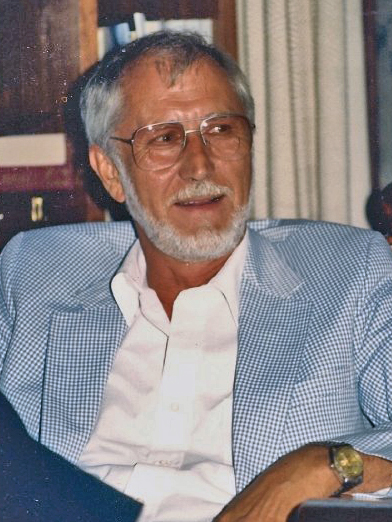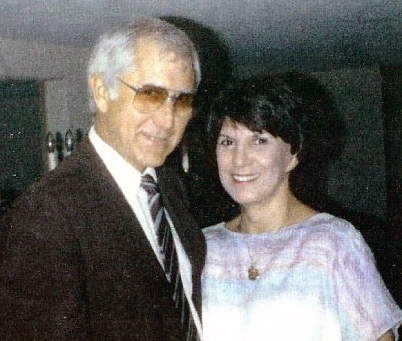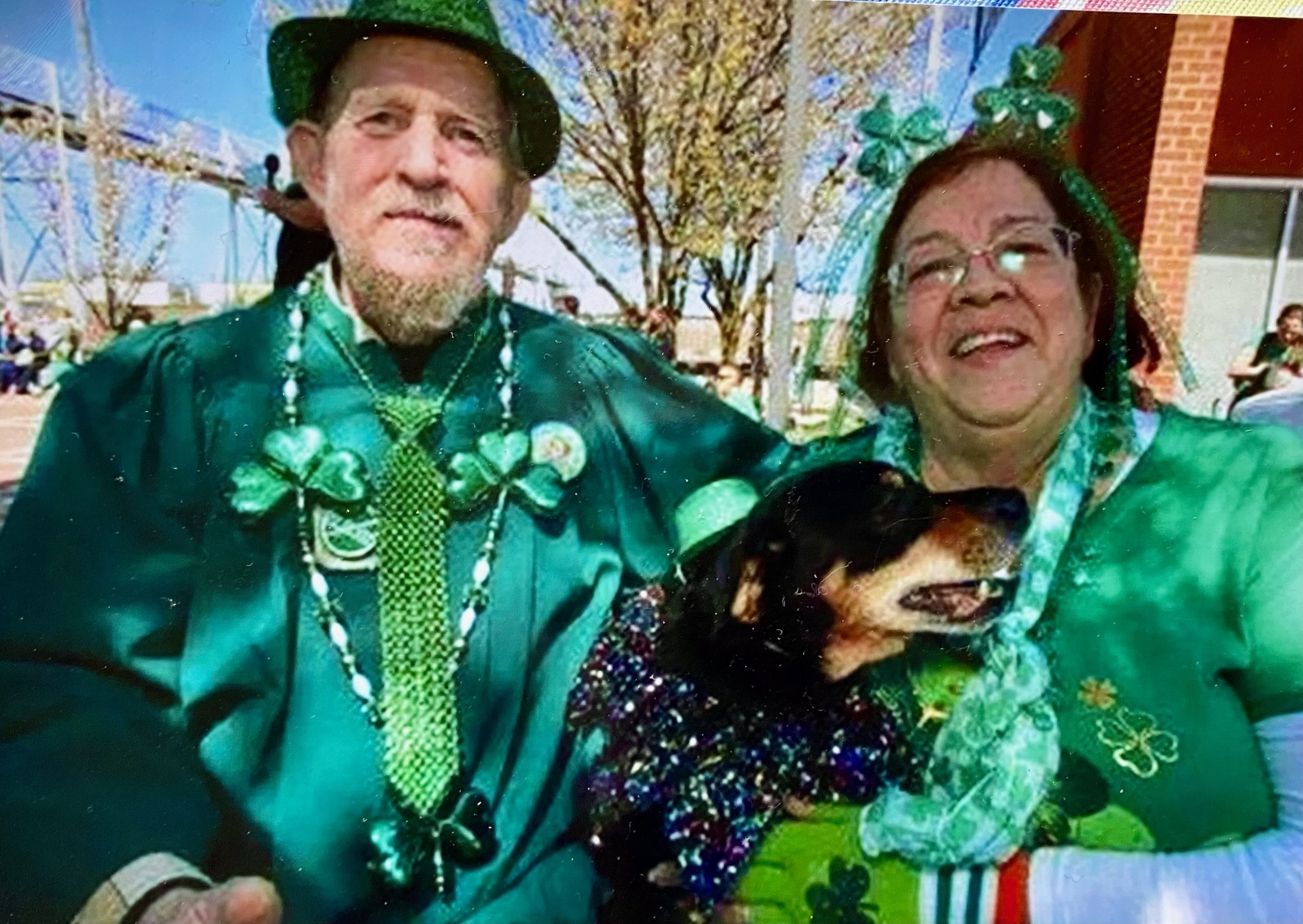William Duane Oatman was an extraordinary example of “following one’s muse.”
William — his friends called him Bill — built a successful Springfield-based career selling lumber and building supplies. But in his 50s he retired from that traditional path and acted on an inspiration to become an artist, specifically a painter.
When he died August 18 at age 91, Bill had enjoyed many years of seeking and capturing beauty, mainly in the Southwestern U.S. and Mexico, and supporting himself by selling his colorful canvases.

No one was more surprised by his late-in-life detour than his kids. They say they had no inkling of their father’s artistic potential.
“None whatsoever,” says daughter Donna Casamento. “I never saw him even pick up a pencil and draw.”
Her sister Debbie Fisher chuckles in agreement: “When we were growing up, he did not paint — other than the side of a house.”
“The one thing that I did know was that he could sing,” says Donna, “He was an amazing singer and whistler. He was a great dancer, too. Watching him and my mom dance was so wonderful; they were a great team on the dance floor.
“But painting? No…”
In retrospect, the girls and their brother, Vernon, perhaps see some clues from his early life.
Bill was born in rugged north-central Nebraska, where his parents, William E. and Anna Oatman, had a cattle operation that sprawled over hundreds of acres.
“It was a huge ranch, and they’d send Dad out for days on end when he was only like 12 years old to check on fences, check on cattle, in summer, winter or whatever,” says Debbie.
Adds Donna: “A couple of years Dad was just dropped off in the middle of nowhere to mind the cattle all winter and survive all alone out there in a cabin. He told interesting stories about being snowed in by rough winter storms, running out of food.
“He learned young how to be independent, and I think it gave him the wandering attitude that he had in the latter part of his life.”
STORY CONTINUES BELOW
Family drawn to Springfield due to Assemblies of God
Bill’s parents were fervent members of the Assemblies of God, and when one of Bill’s sisters enrolled at AG-affiliated Central Bible College in Springfield in 1950, they decided to sell the Nebraska ranch and move to Missouri to be close to her and the denomination’s headquarters here.
Teenage Bill already had left the ranch to compete on the rodeo circuit, and then in 1949 had hung up his spurs and put on the uniform of the U.S. Air Force.
On one leave, he was instructed to go to Nebraska and meet up with a banker who had finalized the sale of the ranch. The banker handed Bill the keys to a car that, according to Debbie, “had a trunk full of money that he was to drive to Springfield and deliver to my grandfather.”
While stationed with the Air Force in Maine near the Canadian border, Bill fell in love with and wed a French-Canadian woman named Mary. After he mustered out of the military in 1953, Bill and his bride came to Missouri to rejoin his parents who, after briefly trying to raise turkeys on a farm near Mount Vernon, had moved to Springfield where Bill’s father started over as a residential and commercial building contractor.
Bill and Mary began their family in a house on West Linwood Street near South Fort Avenue. He worked with his dad some, but soon signed on as a route driver for the Quinn Coffee Co. Then he switched to the Herrman Lumber Co. as a salesman.
Although busy with work, Bill regularly found time for family activities.
“One of the things that we did with Dad that I remember fondly is fishing on Table Rock Lake,” recounts Donna. “We’d help him run trot lines there. We’d camp out, and he enjoyed doing that with us.
“We were not a family of means. One of the most fun things we would do was go to Cox Hospital where there was a fountain that would shoot up streams of water with colors. When we were kids, that was big entertainment! And we’d go to the airport and watch the planes come in, or take drives through the Ozarks — just pile into the car and go look at the leaves.
“We went to Silver Dollar City several times. And it was always a good time to go have pancakes at Village Inn.”
‘A troubleshooter' for lumber yards
In the early 1960s Bill moved the family to Fort Scott, Kan., on assignment with Herrman. They returned to Springfield after a couple years as he took a job with industrial wholesaler Toombs & Co. Then the building supplies business beckoned once more, and by the end of the decade Bill was working for Wickes Lumber Co.
He started out in sales again but soon moved into Wickes management, with assignments that took the family to several Midwestern states, including Indiana, Nebraska and Kansas in addition to Missouri.
“Dad became a troubleshooter for Wickes,” Debbie explains. “He put out fires. If a lumber yard was in bad shape, Dad would go there, figure out what was going wrong and straighten it out.”
Bill’s career with Wickes soared, but by the late 1970s his marriage was on the rocks. He and Mary divorced after 25 years together. He was promoted to a national vice president post for Wickes, with stints in Georgia, Florida, Wisconsin and elsewhere.
Following divorce, a semi-nomadic life
Then in the early 1980s, Bill retired from Wickes and began a somewhat mysterious semi-nomadic life.
“We didn’t have a lot of contact with him during that period. It was pre-cell phone (and no internet yet, either), so it was more difficult to stay in touch than it would be today,” says Donna.
“Contact was very sporadic,” recalls Debbie. “We could usually get ahold of him if we needed to. He always sent birthday cards — and, if we knew his current address, we’d send cards to him. But he was very independent. He didn’t require a lot of friendships. He was kind of a loner.”
Well, not quite.
In the ensuing years, Bill wed four more times — twice to the same woman. Her name was Kathy, and she was an accomplished businessperson and also a budding artist. The kids learned that the couple were attending artist workshops around the country as Bill honed his skills in his newfound passion of painting.
“The first time I knew that he’d dived into painting was when he came for a visit and had a bunch of paintings in the trunk of his car,” says Donna.

Bill’s mother, Anna, had painted as a hobby, and the daughters theorize he may have inherited an artistic gene from their grandmother.
Bill spent time in Mexico, for a time setting up a studio amid the vibrant art scene in San Miguel de Allende. He specialized in rural landscapes and female figure studies, an occasional abstract image — and especially flowers, which had been a favorite focus of his mother’s artwork.
He and Kathy had a condo in Arizona but roamed throughout the Southwest and beyond in a well-equipped motorhome, continuing to attend workshops and art shows and scouting for attractive scenes to paint. His paintings were purchased by private collectors and were sold through several public galleries.
“But we really didn’t get to see much of his art,” laments Donna. “Back then it wasn’t possible to snap a picture and send it to us like it is now with cell phones. And because he sold so much of his art, we just never got to see it.”

‘Very self-critical' of his own work
When age slowed the pace of their travels, Bill and Kathy settled in Sarasota, Fla. He continued to sell his paintings, although he was seldom completely satisfied with their quality.
“I’d go down and visit him in Florida, and there would be some of his paintings around, but he didn’t talk about them much,” says Debbie. “I remember seeing one rather large canvas that I made a complimentary remark about. But he said ‘No, it’s not very good.’ And later I learned that he’d cut it up.
“He was very self-critical. I’d say ‘Dad, don’t destroy them! You are much harder on yourself than anyone else would ever be about your art. We just enjoy that you’re having a wonderful time painting. You’ve got obvious talent. And we really like having your art around.’”
Eventually unsteadiness in his hands and dimming of his eyesight forced Bill to put down his brushes. He devoted time to caring for Kathy as her health declined. She died in 2010.
In 2012, Bill moved back to Springfield, where Debbie and Vernon, who is retired from the construction industry, have continued to live.

(Donna, who at one time was associated with the Humane Society in Springfield, presently is the CEO of IndyHumane, a large animal shelter and adoption operation in Indianapolis, Ind. She plans to return to Springfield when she retires.)
With help from Debbie — who, after 30 years as a kindergarten teacher in Springfield public schools, now is a real estate agent and developer here — Bill made a tidy house on North Columbia Avenue his home until about five years ago, at which time he moved into the Cobblestone Village apartment complex for seniors.
“He probably felt a little confined after he moved back here,” says Debbie. “I think his happiest times were when he was out pursuing his art. But he would come over, and my kids loved to hear his stories. He enjoyed telling stories about his life. He lived through some hard times and some very interesting times, and he knew a lot about a lot of things.”
Bill’s mind wasn’t confined, Debbie notes:
“Even when he was in his 80s, he dreamed of something else he could do. One day he told me he’d heard about these ocean freighters that you could sign onto as part of the crew and then travel.
“He had the wanderlust. He would enjoy a place, and then it was on to the next place.
“He was always thinking of what could be the next place…”








